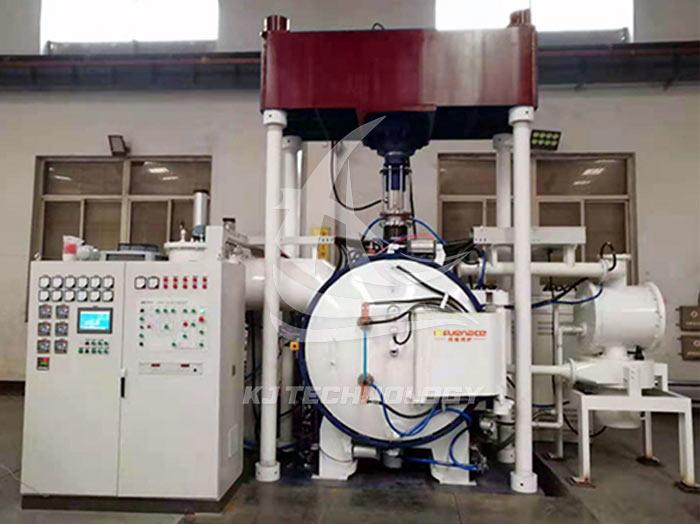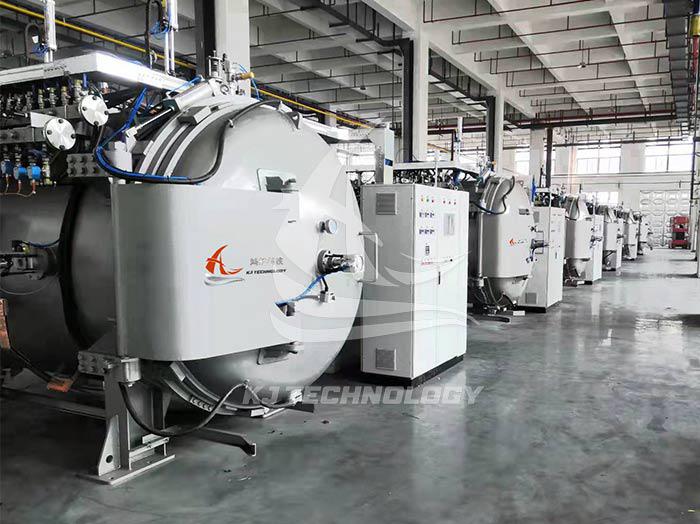Can a vacuum powder sintering furnace sinter metal powder?
 09-09-2025 Author: KJ technology
09-09-2025 Author: KJ technology
The vacuum powder sintering furnace is fully capable of sintering metal powders and has significant advantages in the field of metal material preparation. By combining vacuum environment with precise temperature control, it can effectively solve the problems of oxidation, volatilization, and component segregation of metal powder during sintering, thereby preparing high-performance metal parts. The following is a specific analysis:
1. The adaptability of vacuum sintering to metal powders
Inhibit oxidation and pollution
Metal powders (such as iron, copper, titanium, aluminum, and their alloys) are highly prone to react with oxygen at high temperatures to form oxide films (such as Fe ₂ O3 CuO), Resulting in a decrease in density and performance degradation of the sintered body.
A vacuum environment (usually below 10 ⁻ Pa) can completely eliminate oxygen, avoid oxidation reactions, and remove adsorbed gases (such as H ₂ O, CO ₂) between powder particles, reducing porosity.
Case: Titanium alloy (Ti-6Al-4V) will become brittle due to hydrogen absorption when sintered in air, while vacuum sintering can control its hydrogen content below a certain level and improve its fracture toughness.
Control volatility and component uniformity
Low melting point metals (such as zinc and magnesium) or volatile elements in alloys (such as cobalt in cobalt based alloys) are prone to loss at high temperatures, leading to compositional segregation.
Vacuum sealed system: By precisely controlling the pressure inside the furnace, volatilization can be suppressed, and combined with staged insulation processes (such as pre sintering, main sintering, cooling), component homogenization can be achieved.
Case: After vacuum sintering of hard alloy (WC Co), the cobalt phase distribution is uniform and the bending strength is improved.
Promote liquid-phase sintering and densification
Metal powder sintering usually relies on liquid-phase filling of pores (such as the melting of copper in Fe Cu alloys). Vacuum environment can reduce the surface tension of liquid phase, accelerate capillary action, and improve the efficiency of particle rearrangement.
Data: After vacuum sintering, stainless steel powder has a higher density and significantly improved hardness compared to air sintering.
2. Types of sinterable metal powders
iron base alloys
Stainless steel powder (304L, 316L): used for manufacturing corrosion-resistant valves and pump bodies. After vacuum sintering, the surface roughness is small and does not require subsequent polishing.
Tool steel powder (H13, M2): After sintering, the hardness increases and the wear resistance is better, making it suitable for molds and cutting tools.
superalloy
Nickel based alloys (Inconel 718, 625): used for aircraft engine turbine discs, vacuum sintering can eliminate grain boundary oxidation, and the tensile strength retention rate is higher at 1200 ℃.
Cobalt based alloy (Stellite 6): excellent wear and corrosion resistance after sintering, suitable for coating gas turbine blades.
Light metals and refractory metals
Titanium alloy powder (Ti-6Al-4V): Vacuum sintering avoids hydrogen embrittlement and prepares orthopedic implants with longer fatigue life.
Tungsten and molybdenum powders: After sintering, their density increases and they are used as semiconductor sputtering targets and X-ray tube cathodes.
magnetic materials
NdFeB: Vacuum sintering can control grain orientation and is used for high-performance motor magnets.
Ferrite powder: sintered with higher magnetic permeability, suitable for core components of inductors and transformers.
Precious metals and special alloys
Platinum group metals (platinum, iridium): Vacuum sintering avoids high-temperature volatilization loss and is used for fuel cell electrodes and catalyst carriers, with better purity.
Gold based alloy: Excellent conductivity after sintering, used for electronic connectors and bonding wires.
3. Process advantages of vacuum sintering metal powder
Low temperature sintering and energy saving
A vacuum environment can lower the melting point of metals (such as copper, which has a melting point decrease of about 50 ℃ under vacuum), thereby lowering the sintering temperature (usually 50-100 ℃ lower than air sintering) and reducing energy consumption.
Case: The vacuum sintering temperature of aluminum based composite materials (Al SiC) was reduced from 650 ℃ to 600 ℃, which is more energy-efficient and avoids interface reactions between SiC particles and aluminum matrix.
Ability to form complex shapes
By combining powder injection molding (MIM) or 3D printing technology, vacuum sintering can directly prepare near net formed parts (such as gears and impellers), reducing subsequent processing volume.
Data: The dimensional shrinkage rate of MIM stainless steel parts after vacuum sintering is controllable.
Environmental Protection and Clean Production
The vacuum system operates in a closed manner, with no exhaust emissions, making it more environmentally friendly.
Comparison: Traditional air sintering requires subsequent acid washing to remove oxide scale and produce wastewater containing heavy metals, while vacuum sintering does not require this step.
4. Typical application scenarios
aerospace
Using a vacuum sintering furnace to prepare LEAP engine turbine discs reduces costs, extends lifespan, and improves fuel efficiency.
automotive industry
Using vacuum sintering powder metallurgy gears improves transmission efficiency and reduces noise, replacing traditional forged gears.
medical device
Vacuum sintered titanium alloy hip joint enhances the bonding strength with bone tissue and reduces postoperative looseness rate.
electronics industry
By using vacuum sintered aluminum nitride substrate, the heat dissipation efficiency of the fast charging module is improved and the volume is reduced.








